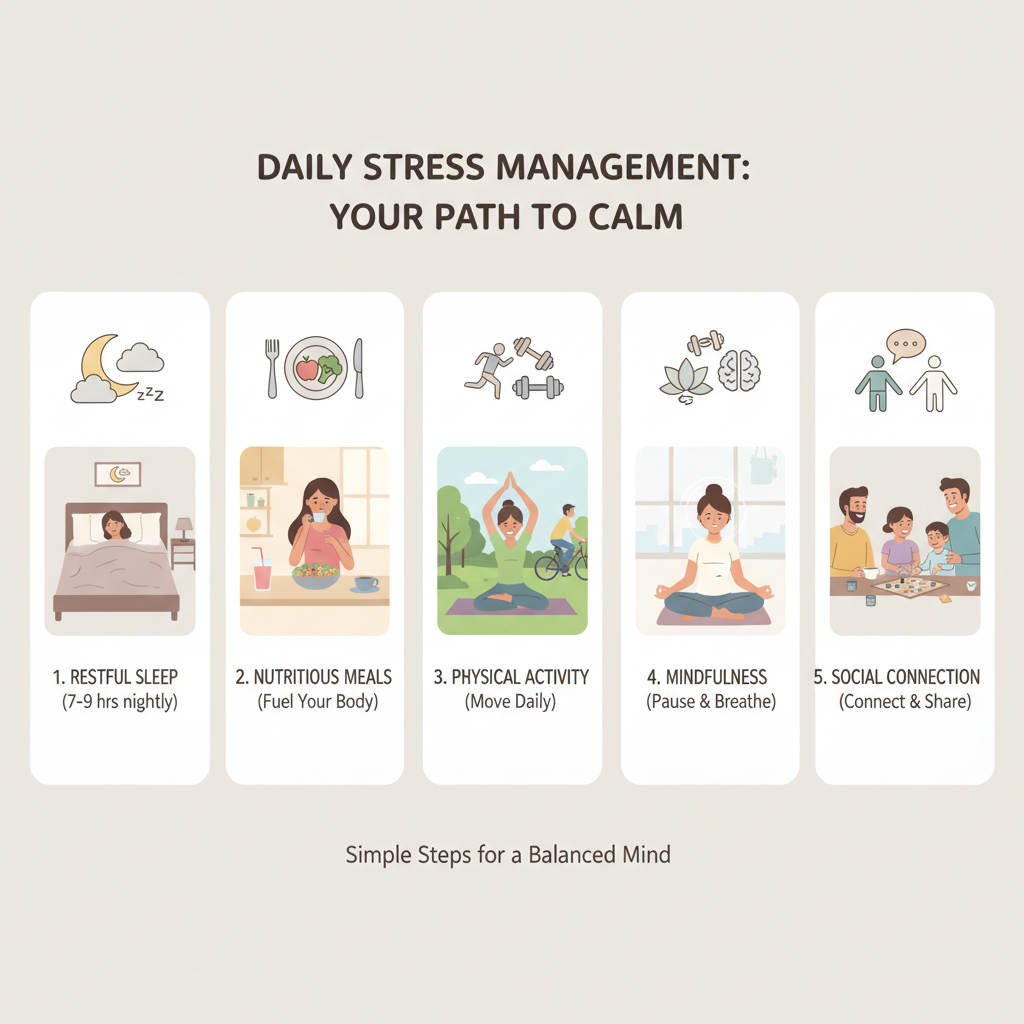Daily Stress Management Checklist: Simple, Effective Tips for Everyday Calm

Why Use a Daily Stress Management Checklist?
Imagine trying to assemble IKEA furniture without the little booklet telling you which screw goes where. Chaos and frustration would quickly follow. Similarly, managing stress without a clear plan can feel overwhelming and ineffective.
The daily stress management checklist is not about achieving perfection or eradicating stress entirely—because let’s be honest, stress is more like that awkward relative at family events: unavoidable but manageable. This checklist transforms vague ideals like “take care of yourself” into manageable, bite-sized actions. Think of it as your daily reminder to prioritize mental well-being instead of letting stress spiral out of control.

The Daily Stress Management Checklist: Step-by-Step
1. Get Enough Restful Sleep (7–9 hours)
Adequate sleep isn’t just a luxury—it’s essential. Think of it as your brain’s overnight spa treatment. Aim to unplug from screens at least 30 minutes before bedtime—including that adorable puppy video on your phone—and maintain a consistent sleep schedule. Your well-rested future self will thank you.
2. Eat Nutritious, Balanced Meals
Consuming junk food regularly can increase stress levels and worsen anxiety. Instead, nourish your body with vegetables, lean proteins, whole grains, and healthy fats. These foods act as natural stress bouncers, stabilizing your energy and helping you stay calm during unexpected challenges like last-minute Zoom calls.
3. Engage in Physical Activity (20–30 minutes)
Exercise doesn’t require channeling your inner athlete. Simple activities such as walking your dog, practicing yoga, or dancing freely release endorphins—the body’s natural mood elevators. These help transform feelings of anxiety into calmness, much like a graceful swan gliding across a pond.
4. Practice Mindfulness or Relaxation Techniques
Taking five to ten minutes daily to pause with deep breathing, guided meditation, or gentle stretching can reset your nervous system much like a computer reboot. This mindful approach smooths the rough edges of a stressful day. Even children recognize the power of deep breaths for reducing tension.
5. Take Regular Breaks and “Me Time”
You’re not a machine. Scheduling breaks for hobbies, casual daydreaming, or quiet reflection helps prevent burnout. Feel confident knowing you’re following your stress relief checklist—a practical and effective strategy to maintain your well-being throughout the day.
6. Connect with Supportive People
Humans are inherently social creatures. Reaching out to friends or family through a quick chat or text boosts oxytocin, the so-called “cuddle chemical,” which instantly uplifts your mood. For more on building strong social connections, explore our guide to supportive relationships.
7. Identify and Reflect on Stressors
Journaling offers more than teenage angst relief; it’s a proven tool to increase emotional clarity. By noting your stressors and how you respond to them, you gain valuable insight to avoid or handle future stress more effectively. Check out our journaling techniques for emotional health for deeper tips.
8. Set Realistic Priorities and Boundaries
Trying to do it all is a quick route to exhaustion. Evaluate your daily tasks critically and learn to say “no” confidently. Protecting your time and energy is vital. For strategies on prioritizing effectively, see our time management tips post.
9. Limit Unhealthy Coping Habits
While it may seem tempting, excessive alcohol or coffee intake can amplify stress rather than alleviate it. Cutting back on these substances supports better anxiety management and overall health.
10. Practice Gratitude Daily
End each day by writing down three genuine things you’re thankful for—no cheating with “I’m grateful for Netflix.” This simple habit rewires your brain to focus on positives and reduces anxious “what if” thinking.

Personal Tips from Experience
Why Bundt Cakes and Stress Relief Might Share a Secret!
Baking bundt cakes became my mindful ritual; the repetitive mixing, delightful aroma, and sharing slices grounded me in the moment, steering attention away from relentless worries. Discover your own “bundt cake” activity—whether gardening, doodling, or listening to music—that helps center your mind and ease your stress.
Ganache and Mindful Moments
Imagine your day as a cake, with mindfulness as the smooth ganache glaze that softens rough edges. Even a single mindful breath can transform your outlook and inspire calm. Give it a try—you may find yourself craving more moments like these.

Additional Resources
Looking to deepen your stress management skills? Explore these helpful resources:
- 10-Minute Mindfulness Meditation Guide
- Easy Home Workouts to Beat Stress
- Healthy Meal Prep for Busy Days
- Journaling for Emotional Health
For authoritative insights, check out:
FAQ: Your Daily Stress Management Questions Answered


